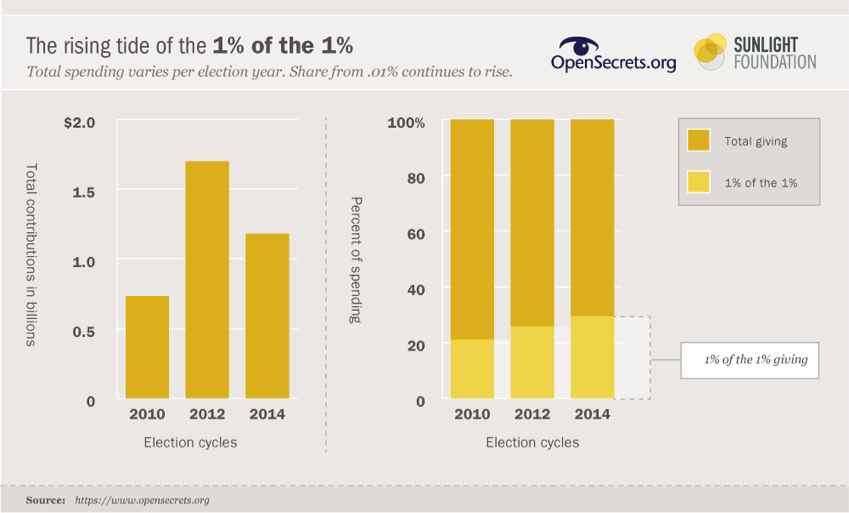In an era when just about every major Republican and Democratic presidential aspirant has a campaign sugar daddy, the role of big money in politics has never been more crucial.
As The Washington Post noted this week, “Never have so many candidates entered a White House contest boosted by such huge sums.”
Related: Super PACs: Dems’ Single Donors Outspent the GOP’s by 400 Percent
Sure, former Florida governor Jeb Bush boasted raising tens of millions of dollars for his allied super PAC. That hasn’t been nearly enough to thwart Sens. Marco Rubio of Florida, Rand Paul of Kentucky and Ted Cruz of Texas or Wisconsin Gov. Scott Walker from raising comparable sums to propel their campaigns.
In the wake of the Supreme Court’s 2010 Citizens United decision that opened the floodgates to independent expenditures for campaign, candidates for president and Congress have been raising record sums. But where is that money actually coming from?
In the 2014 elections, 31,976 donors — equal to about one percent of one percent of the total population of the United States – accounted for an astounding $1.18 billion in disclosed political contributions at the federal level, according to a new report by the Center for Responsive Politics and the Sunshine Foundation, two non-partisan campaign spending watchdogs.
“Those big givers — what we have termed the Political One Percent of the One Percent — have a massively outsized impact on federal campaigns,” according to the report.
Related: GOP Race Shaping Up as Long, Chaotic Battle of the Billionaires
A profile of this highly elite group of political kingmakers shows, among other things:
- They’re mostly male, they tend to be city-dwellers and often work in finance.
- Slightly more of them skew Republican than Democratic.
- A small subset — barely five dozen — gave more than $1 million each. And a minute cluster of three individuals contributed more than $10 million apiece.
- The $1.18 billion they contributed represents 29 percent of all fundraising that political committees disclosed to the Federal Election Commission in 2014.
- Though both parties depend on these donors, the GOP received more from them than Democrats.
Not surprisingly, Wall Street continues as the most influential sector among the One Percent of the One Percent, both in the number of donors that made the list and the money given. Contributors who listed employment in the securities industry spent about $175 million in 2014, of which $107.5 million went to committees supporting Republicans.
The top three financial benefactors in 2014 each contributed more than $10 million. Heading that list was Tom Steyer, the liberal San Francisco hedge fund manager and environmentalist who accounted for $73 million alone. The vast majority of that money went to super Democratic PACs targeting GOP candidates.
Steyer was followed by former New York Mayor Michael Bloomberg, a political independent, with $28.4 million and New York financier Paul Singer, a Republican, with $11.2 million.
Related: High Court Gives Wealthy Donors More Freedom in Campaign Contributions
“The donors at the very top of the money pyramid provided the financial fuel for many of the attack ads and other messages from independent organizations that filled the airwaves last year,” according to the report. A previous analysis by CRP found that the country’s top 100 donors accounted for 39 percent of the $696,011,919 raised by super PACs in the 2014 elections.”

Who are the One Percent of the One Percent?
The gender and economic sector breakdown of the country’s top donors has remained remarkably fixed over the past three election cycles.
| Cycle | Gender | Donor Count | Total | Party Coded | Dems/ Liberals |
GOP/ Conservatives |
| 2014 | Male Donors | 22,978 | $905,399,299 | $808,159,312 | $362,845,024 | $444,418,056 |
| 2014 | Female Donors | 7,813 | $252,667,524 | $231,486,566 | $126,955,136 | $104,278,930 |
| 2014 | Undetermined | 1,185 | $21,723,398 | $18,348,061 | $14,788,990 | $3,487,359 |
| Source: Center for Responsive Politics and the Sunlight Foundation | ||||||
Top Reads from The Fiscal Times:





